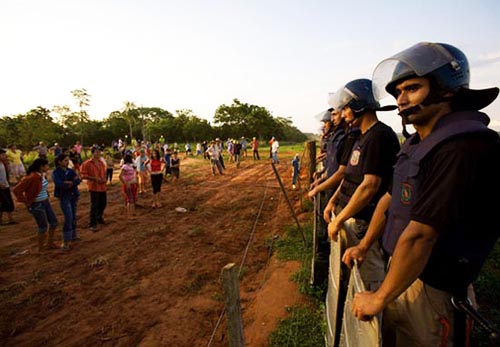
Each bullet hole on the downtown Asunción, Paraguay light posts tells a story. Some of them are from civil wars decades ago, some from successful and unsuccessful coups, others from police crackdowns. The size of the hole, the angle of the ricochet, all tell of an escape, a death, another dictator in the palace by the river.
On June 22 of this year, a new tyrant entered the government palace. The right-wing Federico Franco became president in what has been deemed a parliamentary coup against democratically-elected, left-leaning President Fernando Lugo.
What lies behind today’s headlines, political fights and struggles for justice in Paraguay is a conflict over access to land; land is power and money for the elites, survival and dignity for the poor, and has been at the center of major political and social battles in Paraguay for decades. In order to understand the crisis in post-coup Paraguay it’s necessary to grasp the political weight of the nation’s soil. Here, a look at the history of Paraguay’s resource war for land, the events leading up to the coup, and the story of one farming community’s resistance places land at the heart of the nation’s current crisis.
The Coup and the Land
Hope surrounded the electoral victory of Fernando Lugo in 2008, a victory which ended the right wing Colorado Party’s 61 year dominance of Paraguayan politics. It was a victory against the injustice and nightmare of the Alfredo Stroessner dictatorship (1954-1989), and a new addition to the region’s left-leaning governments. The election of Lugo, a former bishop and adherent to liberation theology, was due in large part to grassroots support from the campesino (small farmer) sector and Lugo’s promise of long-overdue land reform.
Yet Lugo was isolated politically from the very beginning. He needed to ally with the right to win the election; his Vice President Federico Franco is a leader in the right wing Liberal Party and was a vocal opponent of Lugo since shortly after Lugo came to power. Throughout Lugo’s time in office the Colorado Party maintained a majority in Congress and there were various right wing attempts to impeach the “Red Bishop.” Such challenges have impeded Lugo’s progress and created a political and media environment dominated by near-constant attacks and criticism toward Lugo.
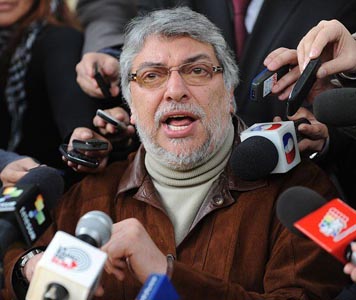
The issue that finally tipped the scales toward the June 22 Parliamentary coup against Lugo was a conflict over land. In April of this year, 60 landless campesinos occupied land in Curuguaty, in northeastern Paraguay. This land is owned by former Colorado Senator Blas N. Riquelme, one of the richest people and largest landowners in the country. In 1969, the Stroessner administration illegally gave Riquelme 50,000 hectares of land that was supposed to be destined to poor farmers as a part of land reform. Since the return to democracy in 1989, campesinos have been struggling to gain access to this land. The April occupation of land was one such attempt. On June 15, security forces arrived in Curuguaty to evict the landless settlement. The subsequent confrontation during the eviction (the specific details of which are still shrouded in confusion) led to the death of 17 people, including 11 campesinos and 6 police officers. Eighty people were wounded.
While certainly the bloodiest confrontation of this kind since the dictatorship, it was but one of dozens of such conflicts that had taken place in recent years in a nation with enormous inequality in land distribution. The right’s response to such conflicts typically involved siding with the land owners and business leaders, and criminalizing campesino activists. With the tragedy of Curuguaty, the right saw yet another opportunity to move against Lugo.
The right blamed Lugo for the bloody events at Curuguaty, an accusation which was unfounded, but served as fodder for the ongoing political attacks against the president. In response to critics, Lugo replaced his Interior Minister with Colorado Party member Candia Amarilla, a former State Prosecutor known for his criminalization of leftist social and campesino groups, and who was trained in Colombia to export Plan Colombia-style policies to Paraguay. Lugo also made the Police Commissioner Moran Arnaldo Sanabria (who was in charge of the Curuguaty operation) the National Director of Police.
In this way, Lugo handed over the state’s main security and repressive powers to the Colorado Party. The move was an an effort to avoid impeachment from the right, but it backfired; the Liberal Party opposed Lugo’s replacements and, empowered by the criticisms leveled against Lugo’s handling of Curuguaty, collaborated with the Colorado Party and other right wing parties in Congress to move forward with the impeachment.
The process began on June 21, and within 24 hours the Senate gathered and officially initiated the trial, granting Lugo only two hours to defend himself. The next day, Lugo was removed from office in a 39-4 vote. He was accused of encouraging landless farmers’ occupations, poor performance as president, and failing to bring about social harmony in the country. Lugo stepped down and Vice President and Liberal Party leader Federico Franco took his place. New elections are now scheduled to take place in April of 2013.
This Parliamentary coup was condemned as undemocratic and illegal by many Latin American leaders who refused to recognize Franco as the legitimate president. In response to the coup, Latin American trade and political blocs such as Unasur and Mercosur have suspended Paraguay’s participation in their organizations until next year’s elections. Unsurprisingly, the Organization of American States decided to not suspend Paraguay’s membership in the group because, according to OAS secretary general Jose Miguel Insulza, doing so would create further problems in the country and isolate it regionally. This is the second such coup in the region in recent years; in June 2009, Honduran President Manuel Zelaya was ousted under similar circumstances.
The backdrop to this political fight is a struggle over how to control, use and distribute Paraguay’s vast land. Approximately 2% of landowners control 80% of Paraguay’s land, and some 87,000 farming families are landless. While Lugo failed to meet many of his campaign promises to the campesino sector, he did in fact work to block many of the right’s policies that would worsen the crisis in the countryside. For example, Lugo and his cabinet resisted the use of Monsanto’s transgenic cotton seeds in Paraguay, a move that likely contributed to his ouster. Yet even before Lugo was elected, political alliances and victories were shaped by the question of land. Multinational agro-industrial corporations are fully entrenched in Paraguayan politics, and their fundamental enemies in this resource war have always been the Paraguayan campesino.
A Sea of Soy
For decades small farmers in Paraguay have been tormented by a tidal wave of GMO soy crops and pesticides expanding across the countryside. Paraguay is the fourth largest producer of soy in the world, and soy makes up 40 percent of Paraguayan exports and 10 percent of the country’s GDP. An estimated twenty million liters of agrochemicals are sprayed across Paraguay each year, poisoning the people, water, farmland and livestock that come in its path.
Managing the gargantuan agro-industry are transnational seed, agricultural and agro-chemical companies including Monsanto, Pioneer, Syngenta, Dupont, Cargill, Archer Daniels Midland (ADM), and Bunge. International financial institutions and development banks have promoted and bankrolled the agro-export business of monoculture crops—much of Paraguayan soy goes to feed animals in Europe. The profits have united political and corporate entities from Brazil, the US, and Paraguay, and increased the importance of Paraguay’s cooperation with international businesses.
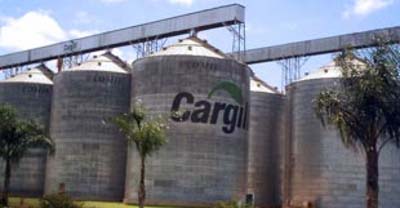
The havoc wreaked by agro-industries has created some of the most grave human rights violations since Stroessner’s reign. A report produced by the Committee of Economic, Social, and Cultural Rights of the United Nations stated that “the expansion of the cultivation of soy has brought with it the indiscriminate use of toxic pesticides, provoking death and sickness in children and adults, contamination of water, disappearance of ecosystems, and damage to the traditional nutritional resources of the communities.”
The expansion of the soy industry has occurred in tandem with violent oppression of small farmers and indigenous communities who occupy the vast land holdings of the wealthy. Most rural Paraguayans cultivate diverse subsistence crops on small plots of ten to twenty hectares, but do not have titles to their land nor do they typically receive assistance from the state. The Paraguayan government has historically represented the soy growers in this conflict by using the police and judicial system to punish campesino leaders.
The small farming community of Tekojoja has been on the front line of this struggle for years. Its history and struggle is representative of countless other farming communities in the Paraguayan countryside.
Tekojoja’s Resistance
The first of several buses we would take from Asunción toward Tekojoja in April of 2009 heated up like a sauna as polka played on the radio. Hawkers came on the bus selling sunglasses, radios, and pirated DVDs. Particularly dedicated salesmen gave impassioned speeches about the superior characteristics of their product, pushing samples onto the unwilling and bored passengers. One sales pitch promised that garlic pills could cure insomnia and cancer.
We passed countless fields of soy and Cargill silos, but also vegetable stands from small farmers and simple roadside restaurants where people could escape into the shade with a cold beer. The dirt road from Caaguazú toward Tekojoja was a rutted expanse of churning red sand; it took us three hours to travel 50 kilometers. The bus fought its way over the deep potholes, the engine reaching a fevered pitch, and every one of its metal bones rattling along with those of its passengers.
That same night, we arrived in Tekojoja and went to Gilda Roa’s house, a government-made structure without running water (though the government built the buildings, it never completed the plumbing). A land and farmer rights activist, Roa’s shirt portrayed plants breaking through a bar code. Inside her house, the walls were covered with anti-soy and anti-GMO posters. She pulled up plastic chairs for us in front of the garden with bright stars as a backdrop, and began talking. Roa spent 2000–2002 in Asunción studying to be a nurse, and had worked as one in a nearby town. At the time of our visit, in April of 2009, she was dedicated exclusively to activism in her community. As Paraguayan folk music played on the radio, and moths bounced around the lights, Roa told us the story of her community and its fight against GMO soy.
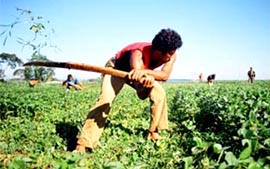
Tekojoja stands on land given to campesinos as part of a Public Land Reform Program. In the 1990s, Brazilian soy farmers—with armed thugs, lawyers, and political connections to protect them—gradually expanded onto the community’s land, forcing a series of violent evictions of the farming families. In 2003, the MAP began to recover the lands taken from them by Brazilians, but corrupt judges and the mercenaries hired by soy producers kept pushing the farmers off their land.
On December 2, 2004, Brazilian land owners accompanied by police burned down numerous houses and farmland in Tekojoja as part of an eviction process. A statement from the MAP described this brutal act:
[A]fter the tractors destroyed our crops, they came with their big machines and started immediately to sow soy while smoke was still rising from the ashes of our houses. The next day we came back with oxen and replanted all the fields over the prepared land. When the police came, we faced them with our tools and machetes. There were around seventy of us and we were ready to confront them. In the end they left.
The campesinos’ houses and crops were destroyed and they had no assurances that the Brazilians would not orchestrate another eviction. Still, as most had no place to go, the community members decided to persevere, staying on the land and fighting for legal recognition as the owners. Roa explained, “We planted seeds with fear as we didn’t know if our crops would be destroyed. And we began to reconstruct the houses.” But again at 4 a.m. on June 24, 2005, the Brazilians and police attacked the community. “They arrested children, blind people, old men, and pregnant women, everyone, throwing them all in a truck.” Roa said. “They threw gas and oil on the houses, burning them all down as the arrests went on.”
In this standoff between the thugs, police, and unarmed campesinos, two farmers, who the Brazilians mistakenly identified as MAP leaders and brothers Jorge and Antonio Galeano, were killed by gunfire. One of the victims was Angel Cristaldo Rotela, a 23 year old who was about to be married, and had just finished building his own home the day before the police burned it to the ground. The wife of Leoncio Torres, the other victim, was left a widow with eight children. A memorial stands in the center of the community in memory of the fallen campesinos.
After the murders, campesinos and activists from around the country rallied in support of Tekojoja, supplying the besieged community members with tarps and food. Finally, the Supreme Court ruled that the land should go to the local farmers, and as part of the reparations for the violence the community suffered, President Nicanor Frutos commissioned the building of forty-eight homes. The plight of Tekojoja sheds light on the situation many farming communities are finding themselves in across Paraguay. While the residents of Tekojoja remain on their land, many others are forced to flee to slums in the city as soy producers push them off their land.
Roa explained this cycle of displacement:
When the small farmers are desperate, and the pesticides are hurting them, there is no money, and so they sell their land for a little money, which is more than they’ve ever had, thinking that life in the city will be better, easy—but it’s not so easy. A lot of people who end up gathering garbage in the city are from the countryside. They don’t know how to manage their money, so for example, they’ll spend all their money on a used, broken-down car first, and then end up in the city broke, without any jobs or place to stay.
The victory of Tekojoja was due to the tenacity of the farmers who refused to leave their land for the false promise of rich city life. But their fight is far from over. Though they tore the soy plants out of their land, residents live sandwiched between seemingly limitless expanses of soy, and they, their animals, and their crops continue to suffer from exposure to toxic pesticides.
By dawn the next day, most of Roa’s neighbors were already up, getting to work before the sun made labor unbearable. Chickens milled about houses, the red dirt yards were still damp from the night’s dew, and radios tuned in to a community radio station mixing music with political commentary in Guaraní. A neighboring community activist invited us to his house to start the day with Paraguayans’ essential beverage, yerba maté served hot in the morning and specially prepared with coconut and rosemary. We sat in his kitchen as the sun streamed through the cracks between the boards in the wall, illuminating ribbons of smoke from the fire, while his children and pigs played on the dirt floor.
An ominous presence loomed over this bucolic scene. The neighboring Brazilian soy farmers had already shown up with their tractors, spraying pesticides on nearby crops. I could smell the chemicals in the air already. We walked toward the fields until the sweet, toxic odor grew stronger. We passed one tractor very closely as clouds of the pesticides drifted toward us. I began to feel a disorienting sensation of dizziness and nausea. My eyes, throat and lungs burned and my head ached, something the locals go through on a daily basis. The physical illness caused by the pesticides contributes to breaking down the campesino resistance.
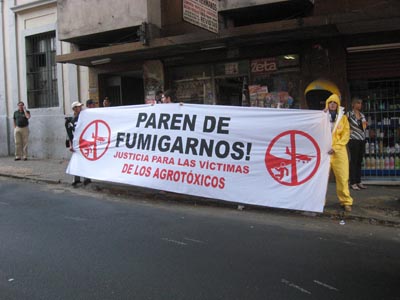
The moped rolled to a stop in front of Virginia Barrientos’ home, a few miles from Roa’s, directly bordering a soy field. The land Barrientos lived on for the past four years is a peninsula jutting into the sea of soy. She occupied her land, which used to be covered with soy, in February of 2005 and won legal ownership to it. But life since gaining the land has been far from easy; pesticides have terrorized her family since they moved there.
“Just before we harvest our food the Brazilians will spray very powerful pesticides,” Barrientos explained. “This spraying causes the headaches, nausea, diarrhea we all suffer.” Her thin children were gathered with her on the porch of the home. “There are a lot of problems with the water,” she continued. “When it rains, the pesticides affect our only water source.”
Barrientos said the pesticides affected her plants and animals as well, making some of the crops that do actually grow taste too bitter to eat. Her pigs’ newborn babies died, and the chickens were ill. Part of the problem, she pointed out, is that the Brazilian soy farmers intentionally choose to fumigate during strong winds which blow the poison onto her land. We passed dead corn stalks on the way to her well, which she insisted on showing us. It was located at the end of a long field of soy, so that the runoff from the field dripped into the well, concentrating the pesticides in her only water source. The family lives in a poisoned misery, while the soy producer responsible for it lives in comparative luxury away from his fields.
Isabel Rivas, a neighbor of Barrientos’ with a big smile and loud laugh in spite of her grim living situation, told us, “When we drink the water we can smell the chemicals. It turns out they were washing the chemical sprayers in our source of water, in a little stream nearby.” Barrientos stood in front of her house while breastfeeding her baby as chickens pecked at peanuts in the yard. Her children stared at us with wide eyes. “We can’t go anywhere else.”
While Lugo’s inability and unwillingness to sufficiently address such hardships was a betrayal of this grassroots sector, the recent coup against Lugo was also a coup against hope, a coup against Barrientos and her children, Roas and her neighbors, and the hundreds of thousands of farmers struggling in the countryside. Behind this coup lies the vast land, some of it poisoned, some still fertile, and much of it tear and blood-soaked. Until the demand of land justice is realized, there will be no peace in Paraguay, regardless of who sleeps in the presidential palace.
***
Benjamin Dangl is the author of Dancing with Dynamite: Social Movements and States in Latin America (AK Press), from which this article includes excerpts, and The Price of Fire: Resource Wars and Social Movements in Bolivia (AK Press). He is the editor of TowardFreedom.com, a progressive on world events and UpsideDownWorld.org, a website covering activism and politics in Latin America. Email: Bendangl(at)gmail(dot)com
